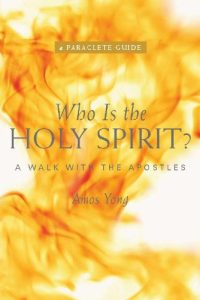
Takeaway: The Holy Spirit is with us today just as he was with the apostles in Acts.
Who is the Holy Spirit uses the parallel books of Luke and Acts to illustrate how the Holy Spirit empowers Christians to do God’s work in the world.
For the last six months of last year I was focused on reading and reading about the gospel of Luke. Spending that much time in Luke really helped to focus me on how intentional the parallels from the gospel of Luke and the books of Acts are. This book takes the parallels and focuses on how the Holy Spirit not only is God, in the same way that Jesus was God in person on the earth, but shows how the Apostles, through the power of the Holy Spirit, worked to fulfill the mission of God just as Christ did.
This is a wide ranging book. And if anything, that would be my main criticism. I almost wish it was more focused. But Yong wants to hit all the major themes and actions of the Holy Spirit in the book of Acts. So there is a very good section on the power of the spirit in salvation and empowering the apostles while they were in Jerusalem.
The economics of Acts and the implications of how the Spirit worked in class, cultural issues, language and racial politics of Israel take a significant role in the book.
The way that Holy Spirit pushes and prods the early church away from their previous understanding and expectations of a kingdom of Israel toward seeing God’s Kingdom as broader than Israel and the fulfillment of scripture is often missed when we already know the story of the church as gentiles.
While I think this was a very good book, the Holy Spirit was at times lost in the story of the early church. Because everything in the book is assumed to be the work of the Holy Spirit, at times it almost seemed like the Holy Spirit moved to the background and became an understood instead of an explicit subject. I would have liked a bit more tangible discussion of the Holy Spirit as the Holy Spirit instead of looking at the Holy Spirit purely through the results of the work that the Holy Spirit has done.
That being said, this is a very good book to take you through the book of Acts. It is very biblically focused and with 39 short chapters it can be read in a lot of short chucks.
Yong is a professor at Regent University and very well known for his books on the theology of disability and the study of Pentecostalism and missions. I am going to get to those. I have had those recommended to me several times before I picked this book up. I did not realize he was the same author, I just picked it up because it was on sale and I am reading about the trinity this year.
Who is the Holy Spirit? A Walk With the Apostles by Amos Yong Purchase Links: Paperback, Kindle Edition
Other books by Amos Yong
The Bible, Disability and the Church: A New Vision of the People of God
Theology and Down Syndrome: Reimagining Disability in Late Modernity
Hospitality and the Other: Pentecost, Christian Practices and the Neighbor
Note: I have to force myself to read quotes of books in book reviews. So I tend to not use a lot of quotes when writing reviews. But these are three very good quotes from the book that will give you a sense of the writing. These three will make the book seem more political and economic focused than it is, but they are quotes that really struck me.
One question for us today, especially we who are on the top side of the global market economy, is whether we would do any different: would we embrace and then live out the “good news of the of the coming kingdom or would we fight to preserve the status quo and our own place in it? If the Holy Spirit were to convict our hearts like Zaccheus’s, our response just might also extend the new economy of salvation so as to reconcile people, oppose and correct the unjust structures of our world, and bring about the healing of many nations.
It is important here to follow the cue provided by Luke to note that “salvation” in Luke and Acts almost never refers primarily to what happens after death, but means, literally, wholeness and health. The healing of this man involved not only the cure of his lameness but also his reintegration into Jewish communal life as represented by his entering the temple. Further, he would no longer be a beggar but could now make contributions as a member of his society. In each of these ways, the good news of salvation had relevance not for the afterlife but for life in the here and now.
The missionary ventures of Paul in these two chapters confirm that the gospel of Jesus Christ is both continuous with and yet also discontinuous from Jewish and Gentile culture and religiosity. The Spirit’s redemption of culture requires a preservation of the old in some respects but also a repudiation of former beliefs and practices in other respects. If the work of the Spirit brought about a renewal, restoration, and reappropriation of all that was good and true in the social, cultural, and religious spheres of human life, it could also be seen from another perspective that the coming of the Spirit turned the world upside down in each of these domains of human endeavor. Continuity or discontinuity, when, and how? These are questions that require ongoing discernment of the Spirit’s presence and activity.
